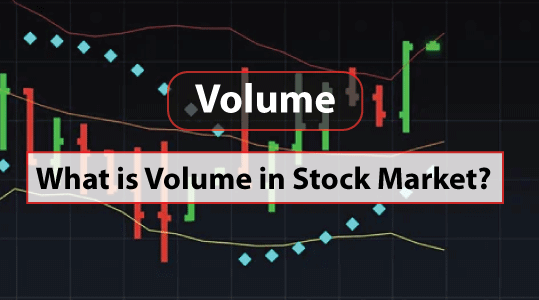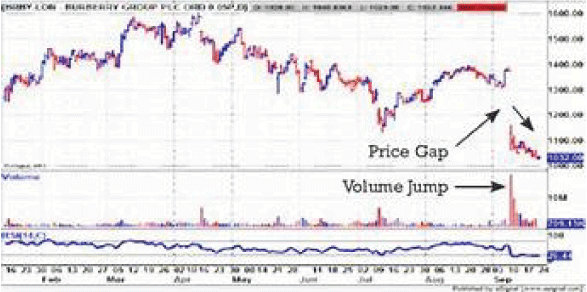What is Volume in Share MarketWhat is Volume?The term volume refers to the number of shares of a particular stock trading at a particular time. Large stocks suggest that investors are more interested in buying and selling them. It can be stimulated by the news and other important events that affect the company. Investors can find trends and compare the current trading volume with its previous. The volume also confirms price trends and warns traders about potential price changes. When investor opinion shifts in a stock's favor, volumes rise, positively impacting its liquidity. 
What is the definition of trading volume?Volume is a metric that measures the total number of stocks traded on a particular period or trading day. It also entails the purchase and sale of each share over a set period. Several investors benefit from volume to assess market trends and patterns. Volume information is readily available whether an investor is discussing the entire stock market or individual stock shares. The total number of shares traded during a trading day, whether they are bought or sold, is referred to as volume. Therefore, if the stock is actively traded on the exchange, the trading volume is high, and if the stock is not traded frequently, the trading volume is low. Several forms of financial instruments, such as derivatives, stocks, bonds, and various commodities, can have their trade volume estimated. The trade volume of various financial instruments, such as derivatives, equities, bonds, and various commodities, can be calculated. The exchange publishes the trading volume of each trading session on the exchange. With the total volume of all and individual stocks traded on the exchange during the trading session, investors can learn about the volume of equities traded on the Sensex or the Nifty 50. Liquidity and VolumeLiquidity is inversely proportional to volume. High-volume shares and other assets are generally liquid. When investors are trying to sell a stock, they are more likely to find a buyer at the price they want when it is traded-in large numbers. Selling, on the other hand, could be difficult with low-volume stocks. When calculating volume, keep in mind that each buy/sell transaction is only considered once. So, if one investor sells 1,000 shares and another investor buys 1,000 shares, the company's total amount will be 1,000 instead of 2,000. 
What is the significance of the volume?Volume is important to investors for easy trading, especially when selling. Investors are optimistic about the company's outlook when quantities and prices are rising. An increase in the trading volume of a particular stock indicates that investors are interested in buying or selling that stock. If the trading volume is increasing, but prices are falling, it may mean that more investors are looking to sell. Some traders look for price points in the recent history of very high-volume stocks. These points can indicate prices at which significant institutional investors consider a good value or desire to sell, which is useful information for retail investors deciding whether to trade or not. Technical AnalysisMany investors use technical analysis to measure price trends and momentum and decide whether to buy or sell stocks. Volume levels are important because they show where the best entrance and exit points are and where the price is heading. It's also used to figure out how significant a market shift is. Based on the volume of the time, the power of the movement can be trusted or skeptical. Tools that are Based on VolumeThe number of securities changes per day is called the trading volume per day. The Average Daily Volume refers to the average number of shares that trade hands each day. It's a great way to see how liquid a stock is and how people feel about it. The liquidity is proportional to the average daily volume and vice versa. The average volume is usually estimated over a 20-day or a month timeframe. The On-Balance-Volume (OBV) is a momentum oscillator-based indicator that detects stock trading pressure. It is a popular clue used in commodities, indices, and forex trading. The stock price on a high day is added to OBV indicator and subtracted from it on the low day. A high day occurs when the closing price exceeds the opening price and vice versa. Traders and investors are still focused on how an OBV fluctuates. The stock is regarded to be in positive momentum if the price and OBV go upward, offering a window for strong buy chances. On the other hand, if the OBV is low, it could indicate a negative tendency. To generate good trade calls, OBV is paired with various additional tools and indicators such as EMAs and RSI. Volume Price Trend (VPT)The VPT is another volume indicator that establishes the supply-demand relationship for stocks. It's utilized to determine where an asset's exit and entry points are. VPT accounts for a percentage rise or decrease in pricing, whereas OBV gauges price change. The formula for it is: VPT = Previous VPT + Volume x (Today's close - Previous closing) / Previous closing It can be calculated daily or weekly to determine the trend's strength. For example, if a stock's volume is large, but there is no significant change in price, it may indicate a poor price trend. In such instances, a reversal of the trend is very likely. VPT is employed again and a slew of other indicators to arrive at a trade decision. RSI VolumeVolume RSI is based on the same premise as a traditional RSI, but instead of prices, it measures volume. Its oscillations range from 0 to 100 percent, with a 50 percent average. When the range moves over 50%, it suggests that the stock is bullish and when it travels below 50%, it shows that the stock is bearish. Bar GraphsAnalysts use the bar graphs to determine volume levels and quickly spot volume trends. Increasing volume as prices go up and down explains strong price fluctuations. Analysts can use volumes to see price shifts on bar charts. If the bar is higher than normal, you have a lot of volume or intensity at a particular price. What is the definition of trading volume?Volume is a metric that measures the total number of stocks traded on a particular period or trading day. It will also entail the purchase and sale of each share over a set period. Several investors benefit from volume to assess market trends and patterns. Volume information is readily available whether an investor is discussing the entire stock market or individual stock shares. The total number of shares traded during a trading day, whether they are bought or sold, is referred to as volume. Therefore, if the stock is actively traded on the exchange, the trading volume is high and if the stock is not traded frequently, the trading volume is low. Several forms of financial instruments, such as derivatives, stocks, bonds, and various commodities, can have their trade volume estimated. The exchange publishes the trading volume of each trading session on the exchange. The total volume of all and individual stocks traded on the exchange. During the trading session, investors can learn about the volume of equities traded on the Sensex or the Nifty 50. Where to look for Trading Volume?All stock exchanges track the volume of all the equities in the market. As a result, it is freely available in the market, allowing investors to obtain information on the volume of a specific stock quickly. Investors can also check trade volume and obtain information from their particular brokers or investment platforms. Many financial platforms utilize candlestick charts to display volume for a specific asset over a specific period. The green color represents buying volumes, whereas the red color represents selling quantities in the volume graphs. Various volume charts provide hourly, daily, and monthly volume charts, depending on the period. However, the trading volumes of the Bombay Stock Exchange (BSE) and the National Stock Exchange (NSE) are very different. What does the Volume of Stocks Indicate?The stock volume indicates that activity has established itself in the stock market. Consequently, whether an investor buys or sells a share, the volume statistic records the action. If a stock has a large volume, it suggests that various actions are taking place around it or that the stock's interest is quite strong. The activity can be both positive and negative, which indicates that there could be an unfavorable conversation about a stock, which could cause the stock's volume to reverse. The term "high volume" refers to the number of timeshares that have been traded on the stock market. As a result, the stock market volume is used to assess liquidity and market activity. If there is a sell order, liquidity indicates that the investor can easily get the money back. When there is a lot of activity in the market, it suggests there are a lot of vendors and buyers. During the outlet and closure of a single buying and selling consultation, volumes live excessive as intraday traders e-books and near their positions in a rush earlier than the consultation finishes. Short-term intraday traders benefit from increased trading volume. Investors that employ fundamental analysis in a trading session will benefit from this tool. Volumes can reverse bull/bear markets, necessitating investor vigilance and detailed knowledge. SummaryVolumes heavily influence stock movements. Various methods and indicators, such as those listed here can be used to understand volumes and volume-based trade calls. While volume is crucial, other aspects to consider when buying a stock. Investors can take a long way to accumulate wealth in the stock market by making thorough choices with all criteria in mind.
Next TopicWhat is Share Market
|
 For Videos Join Our Youtube Channel: Join Now
For Videos Join Our Youtube Channel: Join Now
Feedback
- Send your Feedback to [email protected]
Help Others, Please Share










